
One Bridge, Two Years Ago
"I'll get to it one day." They might not be the exact words I mumbled to myself when I sat down to edit this panorama in September of 2018, but they fit the bill. The photos that I captured to make up the wide-format image had been shot a week earlier, during a nightscape photography weekend at Tuross Head, on the south coast of New South Wales, Australia. All up I took over 700 photos during my stay, so, understandably, I still haven't processed them all.
Despite how the bridge looks in my photo, it's a simple straight span across the Tuross River. The curved look is an optical effect resulting from shooting the panorama so that the Milky Way was at its centre. Riding above the Milky Way, I caught the red planet, Mars, drawing attention to itself as the brightest single object in the field of view. The two Magellanic Cloud galaxies seem to be floating in the sky over the distant bridge approach on the left of the vista.
To create the panoramic image you're looking at I shot 57 single photos, in three rows, using my Canon EOS 6D camera, a Samyang 14mm f/2.4 lens @ f/2.4, using an exposure time of 25 seconds @ ISO 6400.

Murky Milky Mirror
Even at night, with only the feeble photons of atmospheric airglow to light the landscape, you can see that the water in this agricultural dam is a very unappealing colour. The still air on the night left the pond's surface undisturbed, offering me a mirrored but muted view of the treeline, the Milky Way and the light coming from the planet Jupiter. Despite the dirtiness of the pool's contents, you can still see some hues of starlight reflected in the water.
The Magellanic Cloud galaxies are conspicuous in the top-left corner of my panorama, keeping station as they travel through the Local Group of galaxies with our marvellous & majestic Milky Way. I've mentioned that Jupiter is one of the lights shining from the dark mirror, and you can see the source of that light in the sky above the dusty stretch of our home galaxy, as well as the planet Saturn up and to the right of Jupiter's bright beacon. It's frustrating that the clouds conspired to keep me from photographing the stars and planets during last weekend's New Moon period. With very few chances left to shoot the Milky Way's core region as the year draws to a close, so I'll be relying on my trove of shots from previous expeditions–like this one–to keep me posting here.
I created this panoramic photo by shooting thirteen overlapping single-frame images, then merging them using stitching software on my Mac. For each of those individual shots, I used my Canon EOS 6D Mk II camera set to an exposure time of 25 seconds @ ISO 6400 and fitted with a Samyang 14mm f/2.4 lens @ f/2.4.

Three Galaxies. Three Planets
Three Galaxies: Our home galaxy, which we call the “Milky Way,” dominates my photo with its colourful and dust-fringed arch stretched almost the full width of the frame. I captured another two galaxies in this fourteen-shot panorama, namely the Large and Small Magellanic Clouds. These fluffy, puffy orbs seem like they’re floating in the sky in the left side of my photo, able to be blown away by the slightest wind. The two Magellanic Clouds are dwarf galaxies and companions or our Milky Way as it travels through what astronomers call the Local Group.
Three Planets: Our home planet, Earth, is first on the list of planets visible in this scene that I shot at Seven Mile Beach, Australia, last Sunday night, 23 August. About one-third of the way from the right-hand edge of the photo, in the area of sky above the Milky Way, I caught the Solar System’s two most massive planets, Jupiter and Saturn, as they followed our home galaxy towards the western horizon.
The fourteen single frames that I shot to create the panoramic view of these planets and galaxies were all captured with a Canon EOS 6D camera, a Samyang 14mm f/2.4 lens @ f/2.8, using an exposure time of 20 seconds @ ISO 6400.

Beautifully Bent
Our galaxy, the Milky Way, is estimated to be home to at least 100 billion stars. If you or I could travel at the speed of light, it would take us close to 100,000 years to make a trip from one side of this "island universe" to the other. I think I'm not the only person who feels overwhelmed when trying to comprehend the immensity of these kinds of numbers. Perhaps it's because I can't grasp–or mentally "conquer"–the almost divine scale of astronomical objects that fascinates me and drives me to keep pointing my camera heavenwards.
This panoramic view of the Milky Way arching across Tuross Lake, on the southeastern coast of Australia, is one of my attempts at bringing together the enormity of the astronomical and the familiarity of more terrestrial objects. Although the green, red and yellow navigation lights on the lake are bright and conspicuous, I find my eyes quickly drawn to the Magellanic Cloud galaxies (the white blobs in the sky at the left of the frame), and the grand arch of the Milky Way that dominates the majority of the photo. Almost directly above the yellow navigation marker near the centre is the white glow from the planet Jupiter, and you can see its reflection as a little white squiggle down where the water and sand meet.
I photographed this scene in July of 2019, by shooting thirty individual images (in two rows of 15 shots each) that were then stitched together in software to create the final panoramic rendering. To snap each of those frames I used my Canon EOS 6D camera and a Rokinon 24mm f/1.4 lens @ f/2.4, using an exposure time of 13 seconds @ ISO 6400.

Seven Mile Arch
I’m not sure how long it’s been since I posted a Milky Way arch here. I’ve had this one in the can for several months now, so figured it was time to get it in front of some eyeballs.
As well as the Milky Way my photo takes in two other galaxies, the Large and Small Magellanic Clouds. Jupiter, Saturn & Mars are here as well, and I also caught a lot of green atmospheric airglow in the panorama.
The location I captured the sky at on this clear night was Seven Mile Beach, near Gerroa, Australia. I shot 71 overlapping images, with my camera mounted on a “Nodal Ninja” panoramic head.
I shot each of the 71 individual frames with my Canon EOS 6D camera, a Sigma 35mm f/1.4 Art lens @ f/1.8, using an exposure time of 10 seconds @ ISO 6400.
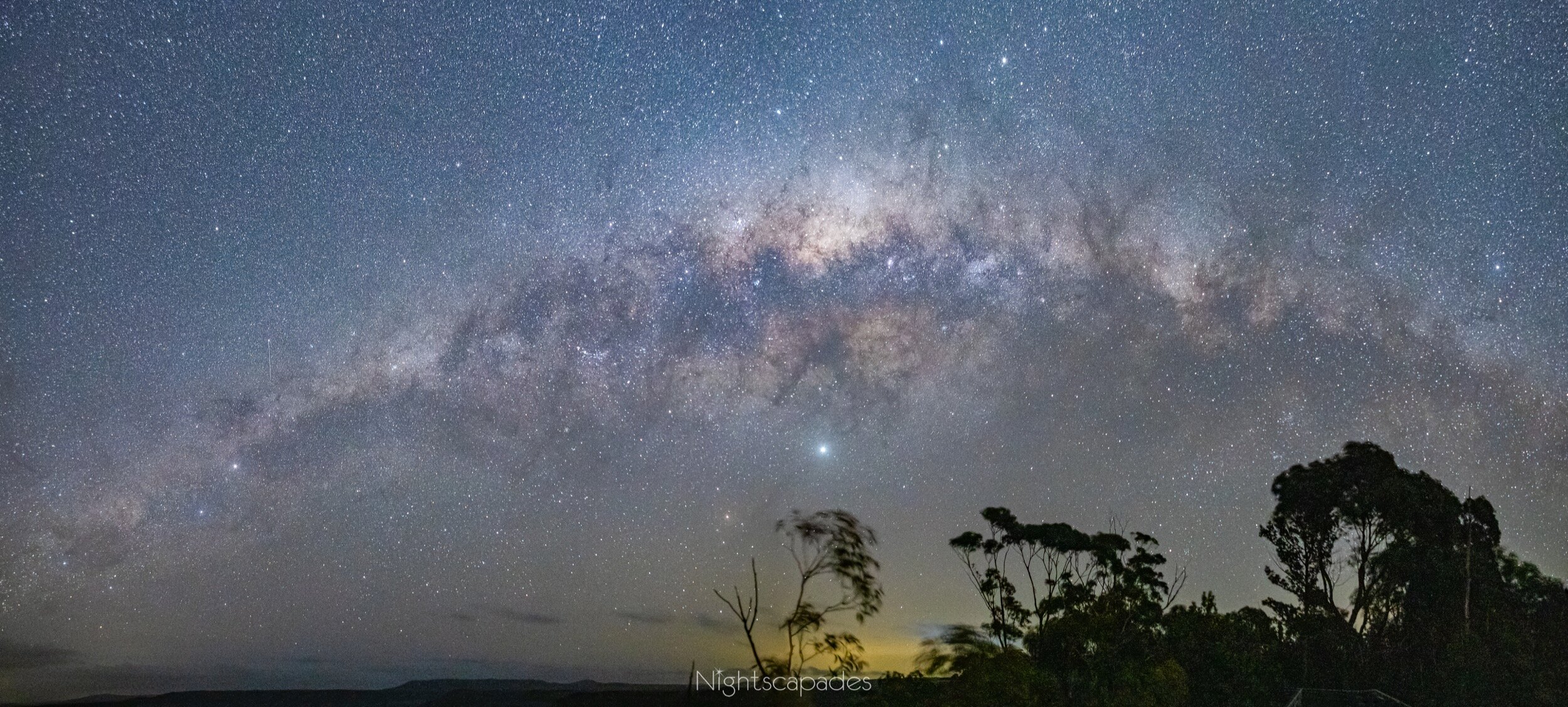
Nine's better than none
After a five-week hiatus from night photography, I drove south to the Jerrawangala national park near Nowra, Australia, on the last Saturday night in September of 2019. Despite the forecast for clear skies, upon arrival, I could see that clouds were quickly moving in from the southwest. My haul for the night was just nine photos, thanks to the weather.
Still, as today’s post title says, nine is better than none. Two of those nine images had overlapping fields of view, so I was able to stitch them together to create the panoramic photo you’re looking at now. It shows the Milky Way’s central band and core region very low in the southwestern sky, with Jupiter lighting the way towards the horizon.
The two photos that I took to create this panorama were captured with a Canon EOS 6D Mk II camera, a Rokinon 24mm f/1.4 lens @ f/2.4, using an exposure time of 15 seconds @ ISO 6400.

Three galaxies from halfway to the top
Australia’s highest mainland mountain is Mt Kosciuszko, located in the Snowy Mountains region in my home state of New South Wales. With its summit at 2228 metres (7310 feet) above sea level it’s by no means one of the world’s tallest mountains but it’s the best we’ve got. Just over 60km to the northeast of that mountain is the spot where I captured this panorama of my beloved Australian night sky. The elevation there is 1000 metres, about halfway to the top, you might say.
There are three galaxies visible in this photo. The largest and most obvious is our own collection of stars, the Milky Way, with its galactic core area hovering over the western horizon just to the right of centre. Over in the top left of the scene are the Large and Small Magellanic Clouds, satellite galaxies of the Milky Way, travelling through space with us on our journey through what is known as the “Local Group” of galaxies. Apart from the two Magellanic Clouds every other star, star cluster and wisp of interstellar dust in this photo is inside the Milky Way. Some clouds way off in the distance obscured some of the Milky Way over on the right of the image.
This panorama was created from thirteen overlapping photos, each captured with Canon EOS 6D, Rokinon 24mm @ f/2.4, 15 sec @ ISO 6400.

A night of lights
Sunday night (28th May) was a night of lights. The Aurora Australis was pumping in the Southern Hemisphere with some fantastic photos coming from places ranging from 35 degrees south and below.. I drove 100km south from home once I saw the reports and photos coming in but by the time I arrived the show was pretty much over. There’s some purple auroral glow on the horizon at the lower right of this image.
On the horizon over towards the left-hand side is the glow from an electrical storm that was way out to sea but still very much visible here and north for about 200km. The lights of the stars in the Milky Way are arching up from near the storm, through the core region and off towards the right. A couple of ships out a sea show as white streaks from their navigation lights forming little trails during the time that the shutter was open. Atmospheric airglow gives the whole shot a slightly purplish tint, not related to the colours added by the auroral glow on the horizon.
This single image is comprised of seven individual shots that were stitched together using Autopano Pro. Each shot was captured with Canon EOS 6D, Samyang 14mm @ f/2.4, 25 sec @ ISO 6400.

Galactic reservoir
Tallowa Dam, in the Kangaroo Valley (Australia), has a viewing platform that is very brightly lit all through the night. The spill from those lights is what has illuminated the hills on the other side of the lake. I used a hand-held LED light bank to show the foreground but my inconsistent light painting has resulted in grass that’s several shades of yellow and green.
My favourite heavenly sight, the band of the Milky Way’s galactic core region, is reigning over the hills and is showing a lot of detail in the strands of interstellar dust. The row of yellow lights on the water’s surface serve as a warning to kayakers, hopefully to keep them from going over the dam’s spillway.
This panorama that was created from 18 single frames, each shot with Canon EOS 6D, Rokinon 24mm @ f/2.4, 15 sec @ ISO 6400.
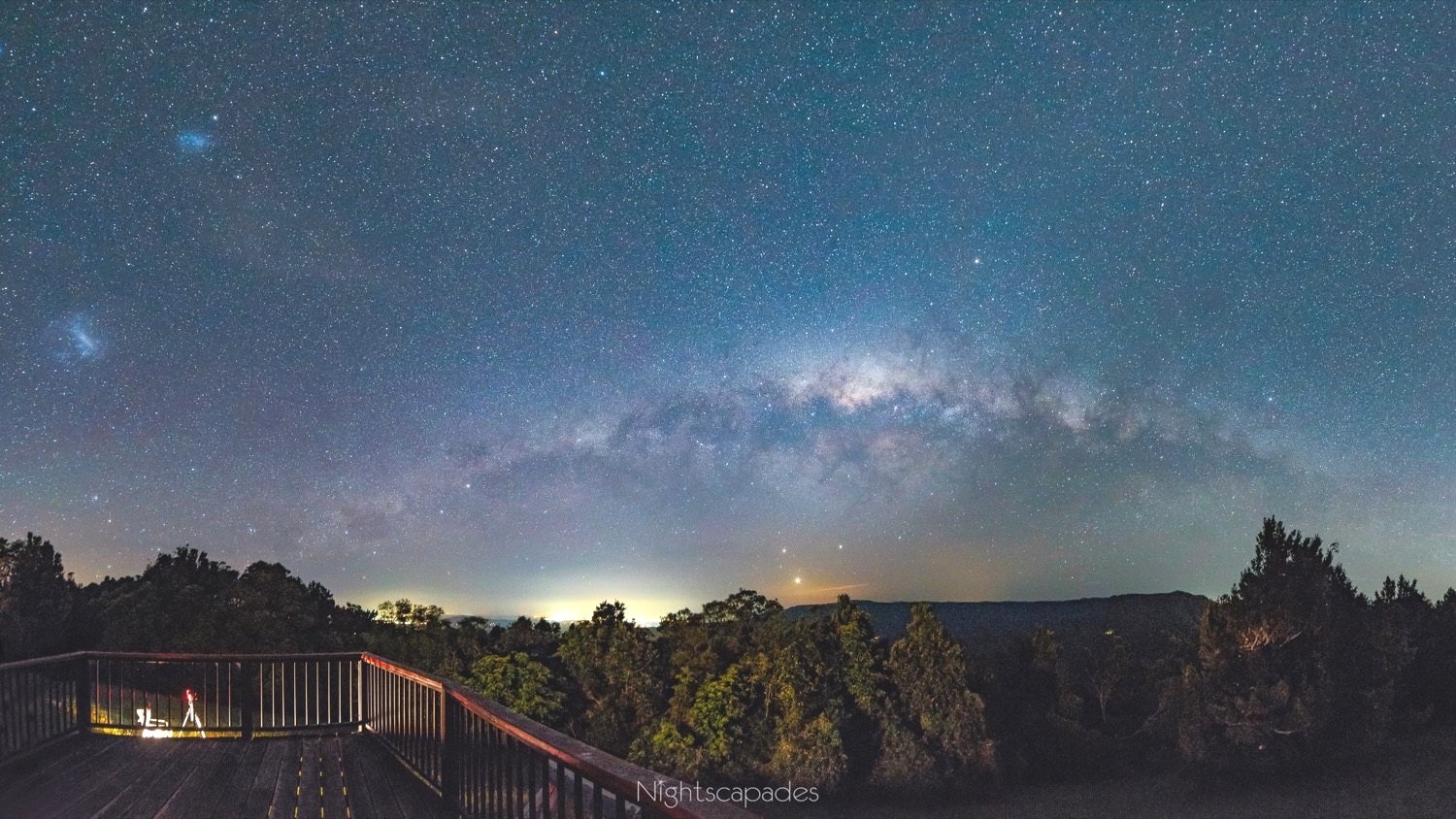
Going, going…
I shot this panorama of the Milky Way in the west back on October 24th of 2016, from ten single photos that were stitched together using the Autopano Pro app.
On the left you can see the Large and Small Magellanic Clouds as they circle the south celestial pole. Venus is just above the horizon a small way to the right of the centre of the photo, with Saturn above and to the right of that. Mars is up above the stretch of the Milky Way. The city of Nowra is responsible for the bright yellow lights on the horizon at the left of centre.
Shot with Canon EOS 6D, Samyang 14mm @ f/4.0, 20 sec @ ISO 6400.

Ruins under the arch
These old silo ruins next to the Princes Highway at Coila, on Australia’s southeast coast, stand firm as the dome of the night sky moves overhead.
Peeking out from behind a tree at left the Large Magellanic cloud, a companion galaxy of our Milky Way, is at the bottom of its circuit of the south celestial pole. The Small Magellanic Cloud is higher up above it, and just above that is the globular cluster 47 Tucanae, looking like a large star here.
Just over the top of the silo are two similarly bright objects, the supergiant star Antares to the left and the planet Saturn almost dead-centre of the tower. The Galactic Kiwi is presiding over the scene higher up over the tower, under the wings of the Milky Way with its swirls and filaments of interstellar dust. The purplish colour of the sky is due to a high moisture content in the air and some atmospheric airglow. I’m still learning the art of foreground lighting as evidenced by the patches of light and dark in the grass between the camera and the silo.
This is a stitched panorama created from 68 individual photos, each shot with Canon EOS 6D, Rokinon 24mm @ f/2.8, 15 sec @ ISO 6400.

The sky over Swan Lake
Swan Lake, on the southeast coast of New South Wales, Australia, is one of the many places that I’ve heard of for years but not ever visited, until October of 2018. I was there on this Sunday night to try to photograph the Milky Way while it was low in the southwestern sky. A few minutes before I shot the last images that make up this panorama, the clouds moved in from the northeast to try and rain on my parade.
Although this part of the coast is only lightly populated, the small holiday townships near the lake still produce their share of light pollution. Cudmirrah, over on the left, was pumping out white light, and near the middle of the shot, the yellow glow on the horizon is from fog-piercing lights on the Princes Highway, about 12 km (7.5 mi) distant. Some campers had a fire burning at the north end of the lake, and I love the little blossom of orange light that they added to the scene.
Mars is riding high over the middle of my photo. The Small Magellanic Cloud, a galaxy, snuck into the lefthand edge, for extra interest. I hope to get back here again before this Milky Way season ends.
I shot 24 single photos to create this panoramic image and took each of those frames using a Canon EOS 6D camera, a Rokinon 24 mm lens @ f/2.4, for a 15-second exposure @ ISO 6400.

Waste, water and wonder
Would I be correct in guessing that most countries are like Australia, where the rural roadsides are littered with manmade waste, to some degree? I hope that you can’t see them when you’re squinting at this photo on your phone, but there are several bottles and cans visible at the bottom of the frame. How lazy, uncaring about the natural environment, or just plain reckless, can people get? At least the waste doesn’t dominate the shot, but the bottles were some of the first things my eyes went to when I was processing this image.
That’s the “waste” part of the title out of the way. The “water” that you see here is known as the Bamarang Dam, a small reservoir west of the rural town of Nowra in the state of New South Wales, Australia. It was a new nightscape photography location for me this year and I look forward to getting back there in 2018.
What’s the “wonder”, you may be wondering? What else but the majestic arch of the Milky Way that dominates the scene. Hundreds of billions of stars, plus immense clouds and “lanes” of dust and gas are responsible for the structure that marks our galaxy’s place on our night skies. Over on the left are the Magellanic Clouds, two companion Dwarf Galaxies of the Milky Way that are like astronomical hangers-on, always there as our enormous “island universe” travels through the cosmos.
This panorama was made from 30 original overlapping images. Each of the photos was captured with a Canon EOS 6D camera, fitted with a Rokinon 24mm wide-angle lens @ an aperture of f/2.4. Each shot was exposed for 15 seconds @ ISO 6400.

Camera vs eyes
You don’t have to look at this image for long to see how well lit up the foreground is. The fields are quite bright and very green, and there’s no mistaking the blue paint job on my car. When I was standing out on the road taking photos, though, things were very different. As I was avoiding using a light to see my way around, to protect my night vision, the only way I could see my car was from the blinking red light of its alarm. It wasn’t until I got home and looked at the photos I’d shot that I saw the cows laying out on the paddocks. Once or twice I stumbled down the little embankment next to the road because I just couldn’t see it.
OK, why does it all look so bright in the photo? To be able to capture all of the details in the sky, such as the stars and planets, and the dust and dark gas in the Milky Way in a photo, your camera needs to take a long exposure, e.g. at least 10-15 seconds. As well as a long exposure time you need to set your camera to a high level of light sensitivity, its “ISO” setting, such as 1600, 3200, 6400 or higher. The combination of these two settings not only lets you gather lots of light from the sky, it also results in you capturing lots of any other light that is around. Out of shot and to the left, about 30km away, is the industrial city of Wollongong, pumping out wasted artificial light all night long. That light pollution spilt onto the fields where I was, bouncing off of the green grass and onto my camera’s sensor. Although I was disappointed to have driven about 100km (60mi) from home to escape the lights of Sydney, only to be bathed in the same stuff here, the light pollution was useful.
The photo is a stitched panorama that I created using the application Autopano Pro. I shot 67 single and overlapping images to make up the pano. Each of those was photographed with this equipment and settings: Canon EOS 6D camera, Rokinon 24mm lens @ f/2.4, 15-second exposure @ ISO 6400.

Wispy wonder over the water
The location I shot this at is Bamarang Dam, southwest of the regional city of Nowra, Australia, just over two hour’s drive from my home. The road sweeps around the eastern perimeter of the reservoir and the bushland falls away to give this view across the water.
There are a few prominent colours in this image, arising from astronomical, atmospheric & earthly causes. In the astronomical realm, stretching from left to right across the middle 1/3 of the scene is the band of our Milky Way galaxy with its billions of stars and the wispy structures known as “dust lanes”. Right in the middle of the photo is the core, the centre, of the Milky Way. Above that is the greenish atmospheric airglow that’s caused by electrons of oxygen atoms in our atmosphere changing orbits and emitting energy as light. There is also some greyish discolouration of the sky in the sky between the Milky Way and the horizon that’s caused by moisture in the air. As for earthly causes you can see the orange glow behind the trees at the centre of the middle 1/3 of the photo. That was caused by the lights of the city of Goulburn, which is about 70km (45 mi) from where the photo was shot.
This image was created by shooting and then stitching together 24 single shots, each captured with Canon EOS 6D, Canon 50mm @ f/2.2, 10 sec @ ISO 6400.
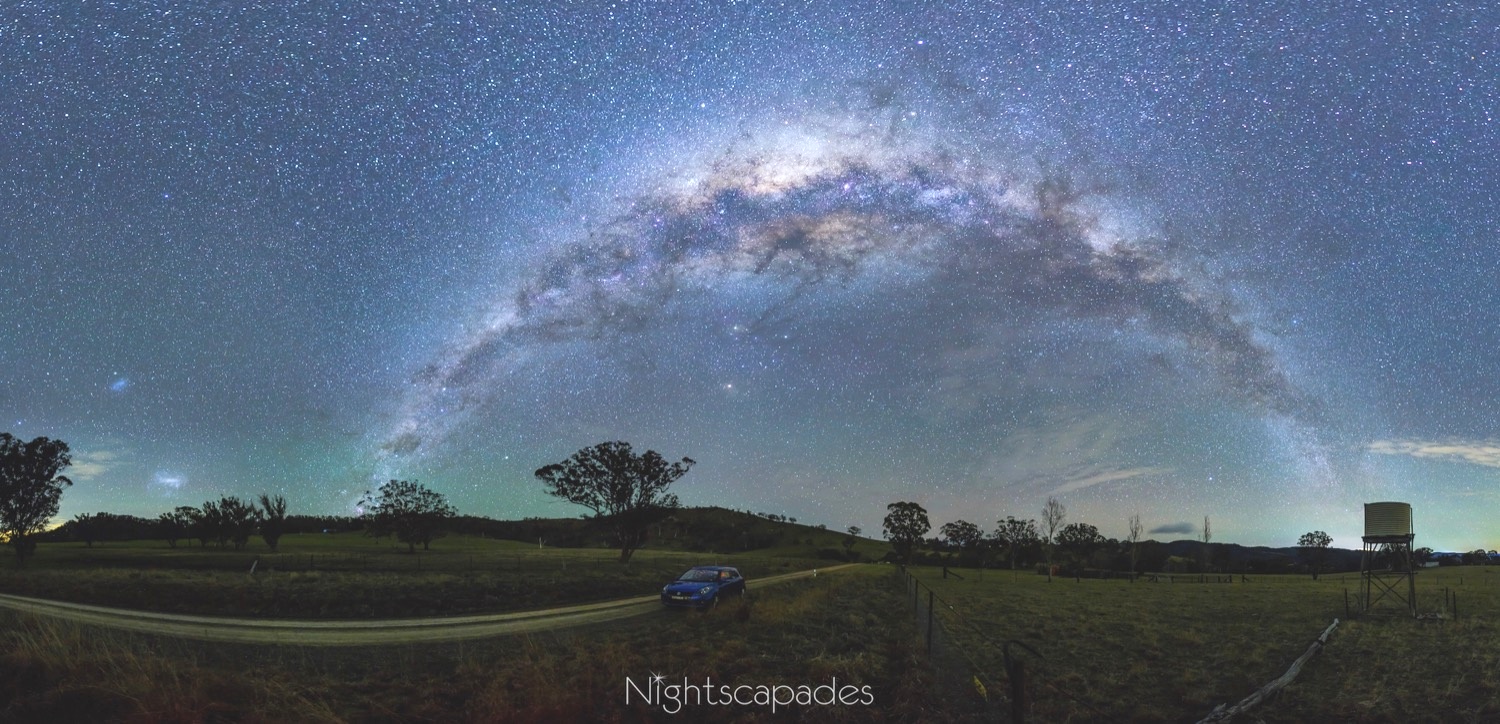
From tree to tank
Like the arc of water flowing from an ornamental fountain, the grand arch of the Milky Way in this piece seems to be emanating from the tree at left and spraying up across the sky before being caught in the water tank on the right. The lush fields and hills in this valley west of Katoomba, Australia, show a different shade of green to that of the atmospheric airglow that’s so prominent near the horizon from the left edge of the shot almost across to the centre. Morphing into a more bluish colour by the top of the image, the sky was very clear and still on this night in late July of 2016.
Also on the left of the shot the beautiful and enchanting wisps of the Magellanic Cloud galaxies. They’re like ladies-in-waiting for their queen, the Milky Way, as she dominates the night. Behind the water tank, off in the distance, the glow from the lights of the city of Lithgow burn into the darkness.
This is a stitched panorama, made up from 65 original images and coming in at almost 1.9GB for the full-res image. Each frame was shot with Canon EOS 6D, Rokinon 24mm @ f/2.4, 15 sec @ ISO 6400.

Luminous Maximus
This night in September of 2018 was the first time that I had ever photographed the blue glow of bioluminescent organisms in the water here at Tuross Lake, Australia. It’s visible at the waterline on the lower left.
Distinct from the individual stars in the photo, the galactic core of the Milky Way, with its billions of suns all glowing together, is giving off a yellowish tone in the sky above the bioluminescence. High over the core is the planet Mars.
I shot each of the 18 individual frames that comprise this panorama with my Canon EOS 6D camera, a Rokinon 24mm lens @ f/2.4, using a 15-second exposure @ ISO 6400.

Straight but bent
This panorama is made up from 45 photos, shot in three rows of 15 frames each. It shows the Milky Way arching over the western sky on the Toolijooa Road near Kiama, Australia. The foreground’s brightness is due to light pollution coming from the cities of Sydney, Wollongong and Kiama on the right and the city of Nowra on the left.
To be able to show the view of over 180 degrees that this image covers, the normally-straight lines at the top and bottom of the photo are curved. For whatever reason our brains are OK with a horizon that looks normal (i.e. it's horizontal) even if other lines are bent. I could have warped the image so that the Milky Way was a straight band of stars but then the horizon would have been curved like a big smiley mouth.
Each of the 45 shots was taken with Canon EOS 6D, Rokinon 24mm @ f/2.4, 15 sec @ ISO 6400.

Majestic Arch
I can't get enough of photographing the Milky Way in different settings, and including a waterway of some kind is one of my favourite compositions. Broughton Creek near Nowra, Australia, is a feeder tributary of the Shoalhaven River. When I visited on this night in 2015 the water’s surface was amazingly flat despite the movement of the tide.
This panoramic image is made up from 16 single frames, stitched together with the application AutoPano Pro. 🌌📷 16 images, each shot with Canon EOS 6D, Samyang 14mm @ f/4.0, 20 sec @ ISO 6400.
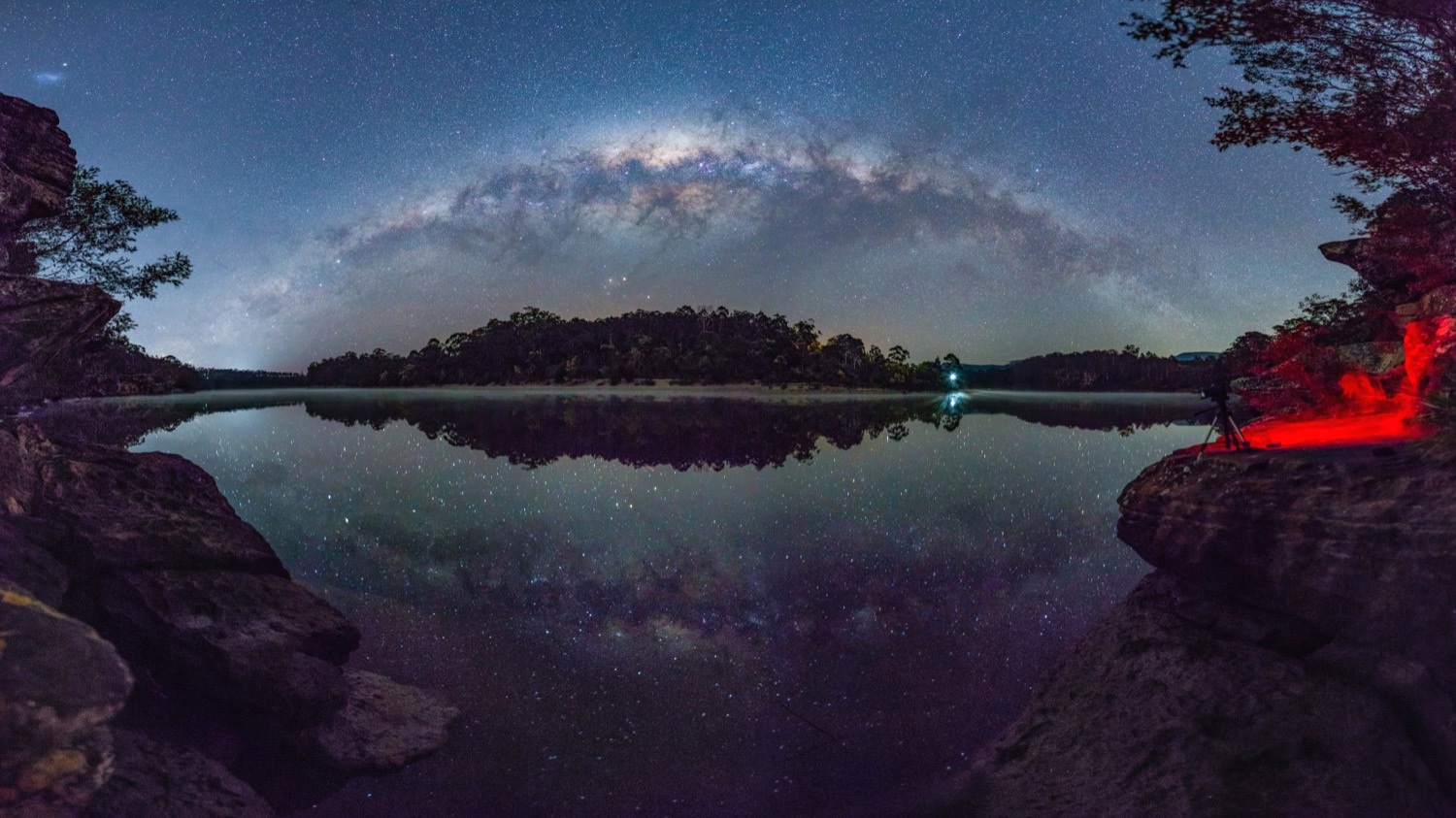
So still!
The tide was just past its peak when I was shooting this scene on a Friday night back in August of 2016. The water was flowing–ever so slowly–down the Shoalhaven River to make its way to the South Pacific Ocean, around 25km away. Despite this movement, the lack of any breeze made the top of the water into an almost perfect mirror.
Up at the top left-hand corner you can see the Small Magellanic Cloud, which is a companion galaxy to our own Milky Way galaxy. The colourful arch of stars, dust and gas that stretches almost right across the image is that same Milky Way galaxy and its “galactic core” region. The planets Mars and Saturn were close to one another in the sky back in August and you can see the two of them, along with the supergiant star Antares, glowing orange just over the tree line near the middle of the shot. All of these celestial wonders can also be seen reflecting off the surface of the river, with a surprising amount of the Milky Way’s structure visible in the mirror image. Spilling red light all over the rocks at right is the tiny LED pilot light in a battery that powers the dew heater keeping my camera lens warm and free from fogging.
This panoramic image was created by shooting 33 overlapping images, in three rows of eleven shots, then stitching the images together in the application “AutoPano Pro”. Each photo was shot with Canon EOS 6D, Rokinon 24mm lens @ f/2.8, 15 sec @ ISO 6400.

A stitched stretch of river
It was around 11:30pm when I finished shooting this panoramic image of a stretch of the Tuross River back in October of 2016. In the seventeen minutes between shooting the first frame (bottom left) & shooting the final frame to make up the pano (top right), a breeze disturbed the river’s surface, leaving me with only 2/3 of an image with stars reflected in the river.
The Milky Way was setting over the trees in the right-hand half of the scene, signalling that our southern-hemisphere’s summer wasn’t far away. The Magellanic Clouds show their usually lovely wispiness at the centre-top, with the sky’s second-brightest star Canopus in a line with the two satellite galaxies. The bright navigation markers on the bridge spilled their light all the way across to where I was shooting, resulting in the red glow of the sand there at the bottom of the frame. Although I thought I’d hidden my camera heater’s battery pack out of sight the mini LED on its case shone a red spot onto the sand, adding an extra point for your eyes to be drawn to.
A panorama stitched from 27 individual frames using Autopano Pro. Each frame was capture with Canon EOS 6D, Samyang 14mm @ f/4.0, 25 sec @ ISO 6400.
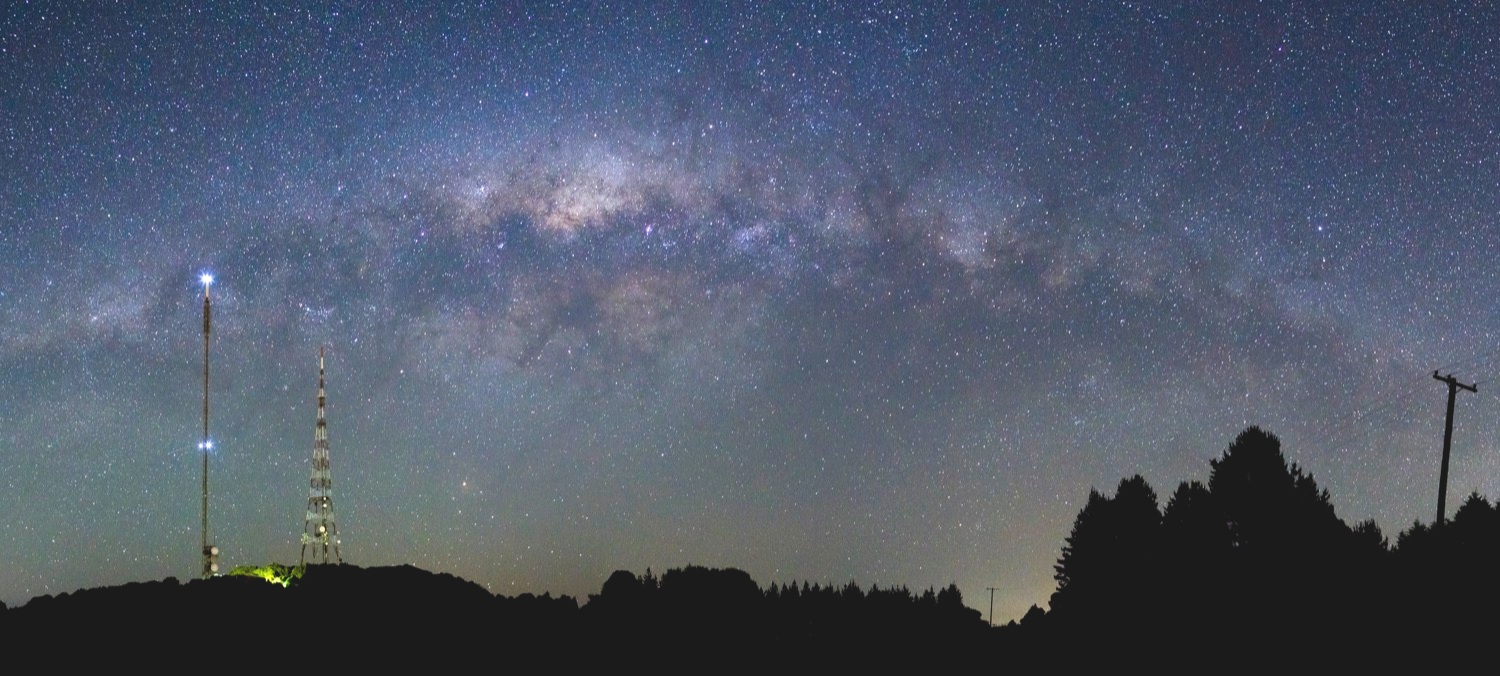
To anyone who's tuned in
TV transmitters send out their signals whether or not anyone is tuned in to watch and listen. In a similar way, the Milky Way broadcasts its beautiful image onto our skies every night. Weather permitting, the beauty is there to be seen by anyone who cares to look; to anyone who bothers to tune in. I love tuning in to this broadcast!
Here in Australia it's now spring and we're heading for summer. This means later sunsets, more humid and less clear skies, and therefore less sharp pictures of the Milky Way as it sets through the thicker horizon. I’m gonna miss shooting this wonder over the summer months. Roll on autumn!
📷
Shot with my Canon EOS 7D, Samyang 24mm lens @ f/2.8, 15 sec @ ISO 5000.

Somewhere special under the stars
Tuross Head, Australia. I’m now in my mid-50s & have been visiting Tuross since for holidays since was 11. It's got two lakes and several beaches and by night has wonderfully dark skies.
This is the first stitched panorama that I ever shot, in October of 2013. I didn’t have much idea of what I was doing and I hadn’t heard of panoramic heads for tripods at this stage. Shooting the 14 frames that make up the image consisted of my taking a shot, estimating how much I needed the next shot to overlap by, then moving the tripod to that position for the next shot.
Centre of frame & just above tree line is Venus, also reflected on the lake.
The processed panoramic image’s dimensions were 10000 x 3333 pixel, with a file size of 240MB. 12 original frames (10x portrait, 2x landscape), stitched in AutoPanoPro Mac, edited in PhotoShop CC & Aperture. Denoised via Topaz Denoise 5. Original RAW frames shot with Canon EOS 7D, Sigma 10-20mm (10mm) @ f4.0, 25sec @ ISO 6400.
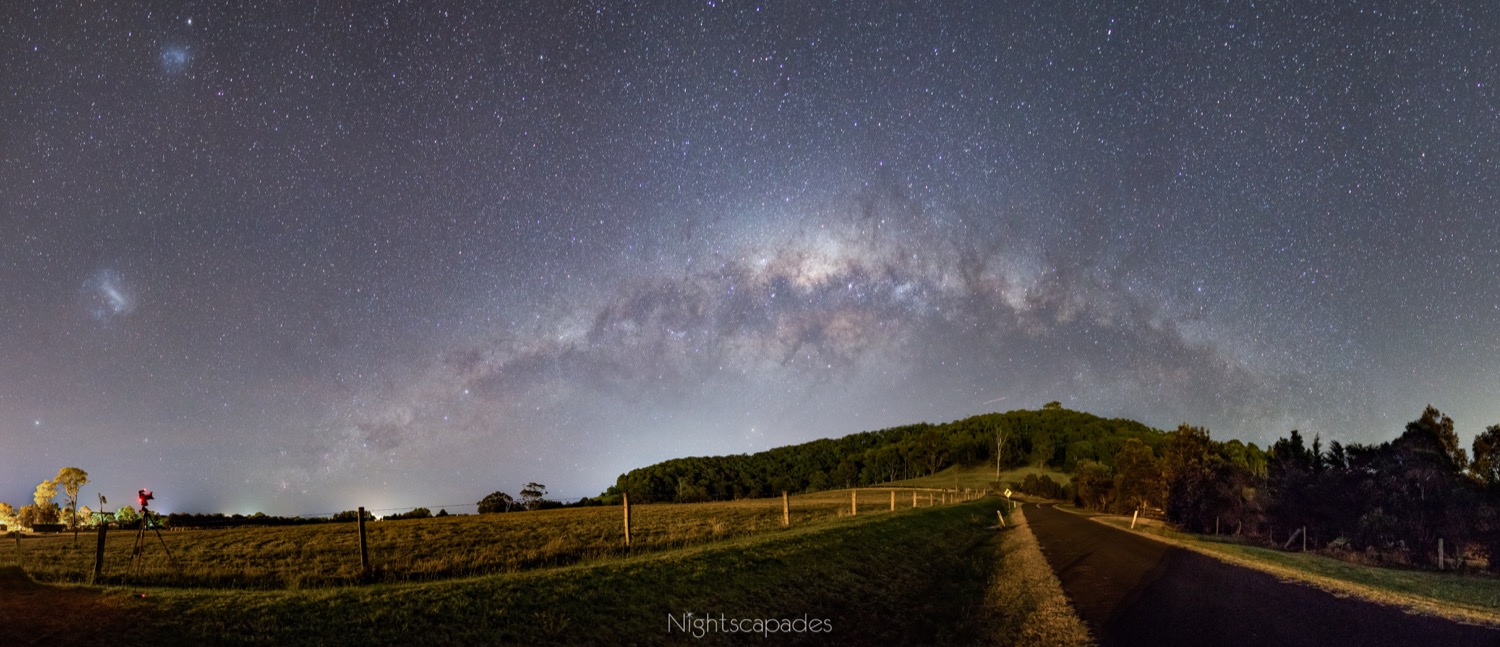
Three for one
The Milky Way has several smaller galaxies that are travelling through space with it (well, with us, in fact). These are known as “satellite galaxies” or “companion galaxies” and of the approximately sixty that have been detected only two are visible with the unaided eye. Named the “Magellanic Clouds”, you can see them at the left of this image, looking like two hazy blobs in the sky. I always find it a bit of a buzz to capture the Magellanic Clouds in the same image as their much bigger brother and hope that you get the same buzz seeing the three galaxies together in a photo like this.
Unless you’re shooting with a very wide-angle lens you can’t get all three galaxies into the one shot but you can use the process of “stitching” to finish up with such a wide photo.
For this image I shot thirteen overlapping images and then used software to blend them (via stitching) into this single scene. Each of the photos that make up today’s image were shot with Canon EOS 6D, Rokinon 24mm @ f/2.4, 13 sec @ ISO 6400.

Three galaxies, a beach and a hill
There’s no missing the Milky Way in this panoramic image that I shot on the beach at Black Head Point, Gerroa, Australia. The time was close to 4:00 am, so the central band and core region of our home galaxy were low in the western sky and in the perfect position to shoot a single-row panorama.
The other two galaxies alluded to in the title of this image are the Small and Large Magellanic Clouds, the two fuzzy and white smudges at the extreme left of the scene. These two dwarf galaxies, which are travelling through space as companions to the Milky Way, live up to their names and look like little clouds handing in the night sky. Down to the left of the Large Magellanic Cloud is the white star Canopus, the second-brightest star in the night sky anywhere on Earth. Directly below this white beacon is a reflection of the star’s light, stretched across the shallow waters in a tidal rock pool.
Gerroa is a great spot for nightscape photography. You can shoot the Milky Way when it’s rising, overhead and setting, all with an interesting landform or horizon in the photo. The drive isn’t too bad, either, taking me a little under 90 minutes to get there from my home in Sydney.
This panorama was created from twelve overlapping images, each shot in portrait orientation and stitched together using the software Autopano Pro. I lit the beach and cliff face using a Tristar 2 SMD LED light, fitted with a 3200K filter. Each of the component images was photographed with a Canon EOS 6D camera, a Rokinon 24mm f/1.4 lens @ f/2.4, using a shutter speed of 13 seconds @ ISO 6400.

Five-galaxy Fiesta
The Taralga Wind Farm in New South Wales, Australia, is a 51-turbine installation that can power around 45,000 average Australian homes per year. I chose the site as the foreground for a Milky Way panorama that I photographed between 1:00 & 2:00 am on Saturday 3rd of August, 2019. Like the title says, this image includes five galaxies, all visible to the naked eye, and I have also noted some other objects that were visible on the night.
The five galaxies you can see in the photo are 1. The Large Magellanic Cloud, 2. The Small Magellanic Cloud, 3. Our home galaxy, the Milky Way, 4. The Andromeda Galaxy, aka M31, and 5. The Triangulum Galaxy, M33. I admit that the fourth and fifth of those are hard to see, but they’re there in the photo, and I could see them even with my 55-year-old eyes. Also captured in the picture is the globular cluster Omega Centauri, as well as the planets Jupiter and Saturn. The photo doesn’t show how cold it was on this night, but this was the first time I’ve seen a 0-degree Celsius reading on my car’s thermometer.
I shot each of the 17 photos that make up the panorama using a Canon EOS 6D camera, a Rokinon 24mm f/1.4 lens @ f/2.4, with an exposure time of 15 seconds @ ISO 6400.

Skies wide open
I covered nearly 500km (310 mi) on the night that I shot this panorama. My first stop of trip was at the 19th-century church and its accompanying graveyard near Crookwell, Australia. The final composite image was a monster 65-image panorama that ended up saving out as a 1.8GB file!
I know there’s a lot of empty sky in the photo, but I cropped it that way so I could include Mars up at the top-right of the scene. You can see the Magellanic Clouds and the globular cluster 47 Tucanae shining clearly on the left. 47 Tucanae is hovering a little to the top-right of the Small Magellanic Cloud. The Milky Way and its galactic core were low in the western sky, and there is a visible glow extending up towards Mars, indicating the presence of the Zodiacal Light.
To create the full-size I captured 65 single images, each of which was shot with a Canon EOS 6D camera, using a Rokinon 24mm f/1.4 lens @ f/2.4, with a 15-second exposure @ ISO 6400.



























